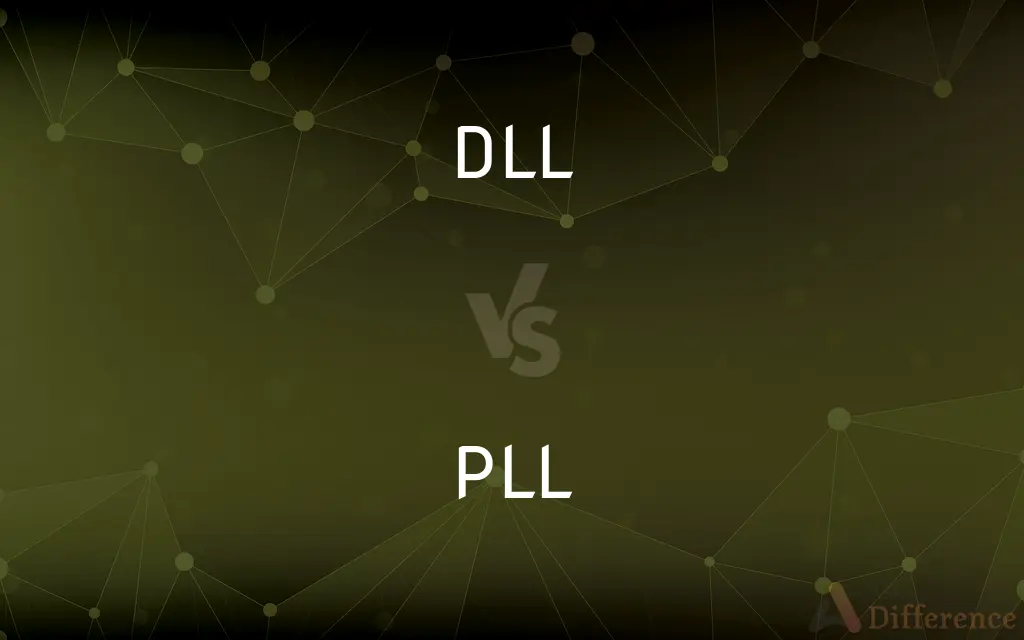DLL vs. PLL — What's the Difference?
Edited by Tayyaba Rehman — By Fiza Rafique — Published on December 31, 2023
DLL stands for Dynamic Link Library, used in software to store code and data, while PLL means Phase-Locked Loop, a control system used in electronics to synchronize signals.

Difference Between DLL and PLL
Table of Contents
ADVERTISEMENT
Key Differences
DLL, or Dynamic Link Library, refers to a file format that holds multiple procedures and functions which can be accessed by a Windows application. In contrast, PLL, standing for Phase-Locked Loop, is an electronic circuit with a voltage or voltage-driven oscillator, mainly used in frequency synthesis and clock recovery.
The concept of a DLL allows for modularity in software applications. It lets different programs utilize the same functions or procedures without having them coded into each application. On the other hand, a PLL is crucial in electronics for its ability to align the phase of its output signal with the phase of an input "reference" signal, ensuring that both signals are synchronized.
For software developers and application users, DLL provides a means of achieving streamlined, efficient, and update-friendly software. If a function within a DLL needs updating, it can be done without affecting the multiple applications that use it. In contrast, for electronics engineers and enthusiasts, the PLL is a cornerstone technology. It's leveraged in numerous devices, from radios to computers, to ensure stability and synchronization in signal processing.
Understanding DLL is primarily relevant in the realm of software development and computer applications. These libraries make it possible for various software pieces to share resources, promoting consistency and efficiency. In juxtaposition, PLL is more about the synchronization of frequencies in electronic devices. It adjusts and ensures that signals in devices maintain a consistent and desired frequency.
While both DLL and PLL play pivotal roles in their respective domains, it's evident that their applications and significance are worlds apart. DLL's impact is most notable in the software ecosystem, allowing for shared resources and modular design. Meanwhile, PLL remains a fundamental tool for electronics, ensuring accurate and consistent signal processing.
ADVERTISEMENT
Comparison Chart
Full Form
Dynamic Link Library
Phase-Locked Loop
Main Application
Software development
Electronics and signal processing
Purpose
Share code and data between applications
Synchronize and stabilize frequencies
Field of Relevance
Computer Science and Software Engineering
Electronics and Telecommunication Engineering
Component Type
Software file format
Electronic circuit
Compare with Definitions
DLL
Can be loaded and executed by different programs.
Multiple programs can call functions from the same DLL.
PLL
Essential for frequency synthesis in electronics.
The PLL helps generate new frequencies based on a reference frequency.
DLL
Used in Windows to promote software modularity.
By storing functions in a DLL, developers can streamline their applications.
PLL
Maintains stable frequencies in many electronic devices.
To ensure a consistent frequency, the system uses a PLL.
DLL
A file format containing multiple procedures and functions.
The application failed to satart because a DLL was missing.
PLL
An electronic circuit for synchronizing signals.
The radio uses a PLL to maintain accurate tuning to stations.
DLL
Supports dynamic runtime linking.
The application dynamically loads the DLL as it starts, ensuring the latest functions are used.
PLL
Key in aligning the phase of input and output signals.
With a PLL, the device ensures that its output signal is phase-aligned with the reference.
DLL
Enables shared resources across software applications.
The image processing functions are stored in a shared DLL.
PLL
Commonly used for clock recovery.
Data receivers use PLLs to extract and synchronize to the clock signal embedded in the data.
Common Curiosities
What is the primary purpose of a PLL?
PLLs synchronize and stabilize the frequencies of signals in electronic devices.
What does DLL stand for?
DLL stands for "Dynamic Link Library."
Can you give an example of where DLL might be used?
DLLs are commonly used in Windows operating systems and applications to store and share code modules.
Where can we typically find PLLs in electronics?
PLLs are found in radios, computers, and many communication devices for frequency synthesis and clock recovery.
Why are PLLs crucial in data communication?
PLLs are essential for extracting and synchronizing to the embedded clock signals in data transmissions.
Why are DLLs important in software?
DLLs allow multiple applications to share functions and procedures, promoting efficiency and modularity.
How is PLL different from DLL?
PLL is an electronic circuit used for synchronizing signals, while DLL is a software file format for sharing code and data.
Is it possible for an application to run without a required DLL?
No, if an application requires a specific DLL and it's missing, the application might fail to run or function correctly.
How can one fix a missing DLL error?
Reinstalling the application, restoring the missing DLL from a backup, or downloading it from a trusted source can fix such errors.
Can DLL files pose a security risk?
If malicious or corrupted, DLLs can pose a risk. It's essential to ensure DLLs come from trusted sources.
Is there a relation between DLL and PLL?
No, DLL is a software concept, while PLL is an electronics concept. They are unrelated except for being acronyms in the tech world.
Are DLL files specific to Windows?
While the term "DLL" is often associated with Windows, similar concepts exist in other operating systems but might have different names.
How does PLL differ from a frequency synthesizer?
While a PLL is a component of many frequency synthesizers, the synthesizer typically combines multiple components to produce desired frequencies.
Do PLLs have any drawbacks?
While PLLs are effective, they can introduce phase noise and might require time to lock onto a new frequency.
How does a PLL stabilize frequency?
PLL continuously adjusts its output to align with a reference frequency, ensuring stability.
Share Your Discovery

Previous Comparison
Definite Integrals vs. Indefinite Integrals
Next Comparison
Hip-hop vs. Ballet DanceAuthor Spotlight
Written by
Fiza RafiqueFiza Rafique is a skilled content writer at AskDifference.com, where she meticulously refines and enhances written pieces. Drawing from her vast editorial expertise, Fiza ensures clarity, accuracy, and precision in every article. Passionate about language, she continually seeks to elevate the quality of content for readers worldwide.
Edited by
Tayyaba RehmanTayyaba Rehman is a distinguished writer, currently serving as a primary contributor to askdifference.com. As a researcher in semantics and etymology, Tayyaba's passion for the complexity of languages and their distinctions has found a perfect home on the platform. Tayyaba delves into the intricacies of language, distinguishing between commonly confused words and phrases, thereby providing clarity for readers worldwide.













































